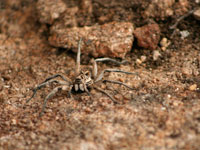Spiders |
 Spiders are common occupants of homes. Usually, the low number of spiders in a house do not cause a problem, but many people are afraid of spiders. Most house spiders are completely harmless, but some species bite, and some spider species are poisonous to humans. In many cases, having a few house spiders is beneficial, as they feed on insects. Spiders feed using their fangs to inject venom into their prey. This venom then liquifies the prey, because the spider's stomach can only handle foods that have been partially digested externally. Some spider species will eat plant material. All spiders have four pairs of legs and most spiders have four pairs of eyes. The eyes of a spider are usually different sizes; the central, frontal pair is the most sophisticated in being able to form images. The other eyes are more rudimentary, and they are not compound eyes like the main pair. Spiders are able to sense their environment using chemical detectors and touch sensors called "setae." Spiders move their legs using two methods: muscles flex the limbs, and hydraulic pressure is necessary to move them back to an extended position. This is the reason why dead spiders have limbs that curl up. Jumping spiders also use this hydraulic pressure to jump high into the air. All spider species produce silk. In some species, the silk is used to make webs that catch prey. When spiders mate, the male often courts the female, who is often larger. Some spider species have females that often eat the males after mating, but this is not the norm for all spider species. Females can lay thousands of eggs in a single egg sac. The egg sac of a spider is made in silk. The female of some species may die after laying eggs, or the female may live to protect the egg sac. The smallest spider in the world is a Columbian spider of the species Patu digua. The largest spider is the Giant Huntsman spider from Laos. It is commonly reported that the largest spider is the Goliath Birdeater spider, a kind of tarantula, but the Goliath Birdeater spider has a shorter leg-span. An interesting case of mimickry in spiders is the ant-mimicking spider. This spider has a modified body that resembles that of an ant. The spider keeps its front pair of legs up in the air to make them look like ant antennae. The spider also has modified hairs on its body and has a dark patch where an ant's compound eyes would be to make it look more like an ant than a spider. The spider even walks like an ant! Spiders may bite humans if they are trying to defend themselves. Most spider bites are harmless. Arachnophobia, or fear of spiders, is one of the most common phobias in existence; it is no surprise that most people would like to rid their homes of spiders entirely. |
FREE QUOTE
Let's Get Started...
Save 20% By Scheduling Online...
Address
 Website Powered by BannerOS. Your Business Energized!
Website Powered by BannerOS. Your Business Energized!





